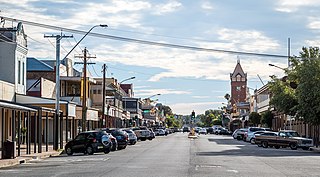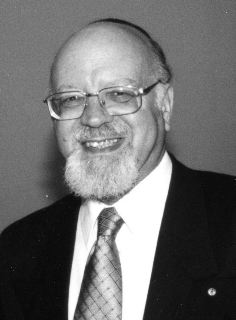
A synagogue, also called a shul or a temple, is a place of worship for Jews and Samaritans. It has a place for prayer where Jews attend religious services or special ceremonies such as weddings, bar and bat mitzvahs, choir performances, and children's plays. They also have rooms for study, social halls, administrative and charitable offices, classrooms for religious and Hebrew studies, and many places to sit and congregate. They often display commemorative, historic, or modern artwork alongside items of Jewish historical significance or history about the synagogue itself.

Broken Hill is a city in the far west region of outback New South Wales, Australia. An inland mining city, it is near the border with South Australia on the crossing of the Barrier Highway (A32) and the Silver City Highway (B79), in the Barrier Range. It is 315 m (1,033 ft) above sea level, with a cold semi-arid climate, and an average rainfall of 265 mm (10.4 in). The closest major city is Mildura, 300 km (190 mi) to the south and the nearest State Capital City is Adelaide, the capital of South Australia, which is more than 500 km (310 mi) to the southwest and linked via route A32, the Barrier Highway.

Cochin Jews are the oldest group of Jews in India, with roots that are claimed to date back to the time of King Solomon. The Cochin Jews settled in the Kingdom of Cochin in South India, now part of the present-day state of Kerala. As early as the 12th century, mention is made of the Jews in southern India by Benjamin of Tudela.
The history of Jews in Australia traces the history of Australian Jews from the British settlement of Australia commencing in 1788. Though Europeans had visited Australia before 1788, there is no evidence of any Jewish sailors among the crew. The first Jews known to have come to Australia came as convicts transported to Botany Bay in 1788 aboard the First Fleet that established the first European settlement on the continent, on the site of present-day Sydney.

Religion in Australia is diverse. In the 2021 national census, 43.9% of Australians identified with Christianity and 38.9% declared "no religion".

The Kahal Shalom Synagogue is an Orthodox Jewish congregation and synagogue, located in La Juderia, the Jewish quarter of the city of Rhodes on the island of Rhodes, in the South Aegean region of Greece. Completed in 1577, the synagogue building is the oldest synagogue in Greece. The congregation worships in the Eastern Sephardi rite, predominately in summer months only.

Raymond Apple was an Australian and Israeli rabbi who worked in England and Australia and retired to Israel. He was the Senior Rabbi of The Great Synagogue of Sydney between 1972 and 2005. In this role, he was one of Australia's highest profile rabbis and the leading spokesman for Judaism in Australia.
A Jewish population has been in Barbados almost continually since 1654.

TheGreat Synagogue is an Orthodox Jewish congregation located in a large heritage-listed synagogue at 187a Elizabeth Street in the Sydney central business district in the City of Sydney in New South Wales, Australia.

The Ancient Synagogue of Barcelona is believed to be an ancient Jewish synagogue located in the Jewish quarter of Barcelona, Catalonia, Spain. Dating to as early as the 3rd century, the synagogue has been described as the oldest in Spain and one of the oldest synagogues in Europe. After many centuries of use for other purposes, the building re-opened as a synagogue and Jewish museum in 2002. No congregation prays regularly at the Ancient Synagogue, however it is used for festive occasions, such as B'nei Mitzvah and weddings.

The White Stork Synagogue is a Conservative Jewish congregation and synagogue, located in Wrocław, in the Lower Silesian Voivodeship of Poland. Designed by Carl Ferdinand Langhans in the Neoclassical style and completed in 1829, the synagogue is located in the city's center, which was the northern edge of the former Jewish district.

Congregation Beth Jacob Ohev Sholom is an Orthodox Jewish synagogue located at 284 Rodney Street in Williamsburg, Brooklyn, in New York City, New York, United States. The congregation follows the Ashkenazi rite.
Congregation Beit Simchat Torah ("CBST") is a non-denominational, pluralistic, progressive LGBTQ+ Jewish synagogue located at 130 West 30th Street, in Manhattan New York City, New York, United States.

B'nai Jacob Synagogue is a former Conservative synagogue in Ottumwa, Iowa. The originally Orthodox congregation was established in 1898, and it constructed the E. Main Street synagogue building in 1915, and joined the Conservative movement in the 1950s.
The Falmouth Synagogue was a former Orthodox Jewish congregation and synagogue, located at 1 Gyllyng Street in Falmouth, Cornwall, England, in the United Kingdom. Established in 1766, the congregation worshiped in the Ashkenazi rite.

The Jewish community of Houston, Texas has grown and thrived since the 1800s. As of 2008, Jews lived in many Houston neighborhoods and Meyerland is the center of the Jewish community in the area.

Historic Congregation B’nai Abraham, officially B’nai Abraham Chabad, is an Orthodox Jewish congregation and synagogue, located at 523-527 Lombard Street, in the Society Hill neighborhood of the Center City of Philadelphia, Pennsylvania, in the United States. Established as a congregation in 1874 and the current synagogue building completed in 1910, worshipers can access daily, Shabbat, and holy day services in the Ashkenazi rite. B'nai Abraham is home to a Jewish Preschool, as well as Lubavitch of Center City.

The Kadavumbhagham Ernakulam Synagogue in Kerala, India, is the restored oldest synagogue of the Malabar Jews with a Sefer Torah scroll and offering occasional services. It was established in 1200 CE and restored several times through the centuries on the same site. It is modeled on the earliest synagogue of the Malabar Jews at Muziris, which dated from the time of ancient sea trade between the Mediterranean and Kerala.















